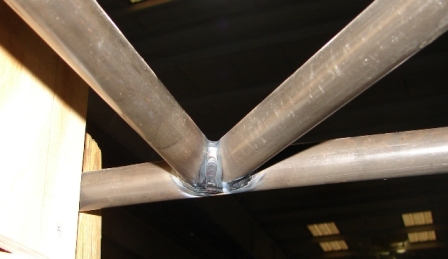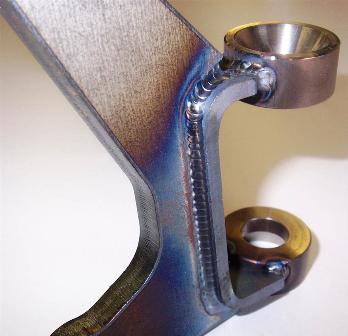OK... so IT's Day 1 of Down and Dirty Welding Metallurgy...Carbon and low alloy Steels
Welcome to welding metallurgy of Carbon and low alloy steels...Day 1 of your crash course on Down and Dirty Welding metallurgy.
Remember from Introduction to down and dirty metallurgy when I said Carbon steel, cast iron, low alloy steels like 4130 chromoly, and straight chromium stainless steel like 410 all harden from heating and then quick cooling? And that Almost everything else does not harden from heating and quenching? And that If you didn’t get this yet, to read it again?
Did you do it? OK here we go then. Next lets talk some more about the down and dirty metallurgy of carbon and low alloy steels.
Welding Metallurgy of Carbon and low Alloy Steels
The most important things to consider when welding carbon steel are cooling rate and how much carbon is in the steel you are welding. Let’s compare 2 extremes here: Low carbon steels which have less than 0.2% carbon as opposed to cast irons which have more than 2 % carbon. (did you catch that? 0.2% vs >2%? That’s 10 times as much carbon!!) Low carbon steels will not harden at all. Oh Really??? I have a theory on that one and it involves Chinese steel and Lead paint. But thats getting into politics and not welding metallurgy.
Lets all picture some Chinese Steel mill worker making 1 dollar a day falling asleep at the Carbon control panel because he moonlights in order to make 2 dollars a day instead of 1. Now picture a good ole southern boy dunking his low carbon steel weld in a bucket of water because he read in his Modern Welding Textbook that low carbon steel won't harden from quenching.
Quality control aint always up to snuff and when you are talking about 1 tenth of a percent that makes the difference on whether something is hardenable, it pays to err on the side of caution. Don’t quench or force-cool carbon steel! That’s all I am saying. A good rule of thumb in down and dirty welding metallurgy is do not force cool carbon steel...
Carbon is the main thing that makes steel harden when it is heated and then quenched. The more carbon, the harder it will get. And cooling rate does not even have to be that drastic if the carbon is high enough. That’s where preheat comes in to play. Preheat slows the cooling rate. Welding codes usually require preheat even on low carbon steels if they are 1 inch thick or thicker Just to be safe. 4130 chromoly is like the next of kin to carbon steel,( kind of like a big brother who works out and takes steroids).
4130 Chromoly is mostly iron with small amounts of carbon, chromium, and molybdenum mixed in. these small amounts of other elements make the carbon have an even greater affect on hardenability. There is even a formula called a carbon equivalent formula that helps predict how low alloys steels will harden.
If you google “welding 4130” you will find precautions about slow cooling. That’s why a lot of general aviation enthusiasts still insist on Gas Welding 4130 because of the slow cooling rate that is built in to the process. (If fact there is a whole community out there of aviation enthusiasts who actually get pissed off if you imply TIG welding is better than gas welding for 4130 chromoly.) There is plenty more to learn if you want to be a metallurgist or something but you don’t.
Do you? Thats what I thought..thats why you are ready Down and Dirty Welding Metallurgy instead of "Look at me...I'm a PHD but I cant find my ass even if I use both hands" metallurgy.
Sometimes when trying to illustrate a point it is helpful to use an extreme example.
My extreme example of how carbon and low alloy steels react to heat is CAST IRON. While Low Carbon Steel only contains about 0.20% carbon, Cast Iron often contains a full 3 %. What???!!!! No wonder it is such a pain in the ass to weld! If Carbon steel that contains 0.3% will harden upon quick cooling , what do you think Cast Iron will do with a full 3 % ?
One Down and Dirty way to get a feel for hardenability is to strike an arc for just a second somewhere on the cast iron part, preferably on a corner where it’s easy to file on the cast iron. Then using the file, compare how the arc strike cuts compared to another area.
Typically, the arc strike will be harder than Japanese arithmetic and the file will slide over it like it was a ball bearing…compared to other areas where the file will easily cut.
This is a down and dirty trick machinists use all the time to tell how hard something is.
When you strike an arc on a small area momentarily it is the same thing as metal heating up to melting point and then quick quenching. Imagine dunking something red hot in ice water. That is the equivalent.
OK here it is one more time because it is just that important. Remember when I said Carbon steel, cast iron, low alloy steels like 4130 chromoly, and straight chromium stainless steel like 410 all harden from heating and then quick cooling? And that Almost everything else does not harden from heating and quenching? And that If you didn’t get this yet, to read it again?
I can hardly wait till you get to day 2 of Down and Dirty Metallurgy. Weldability of Iron Based stainless Steels.
peace out


















